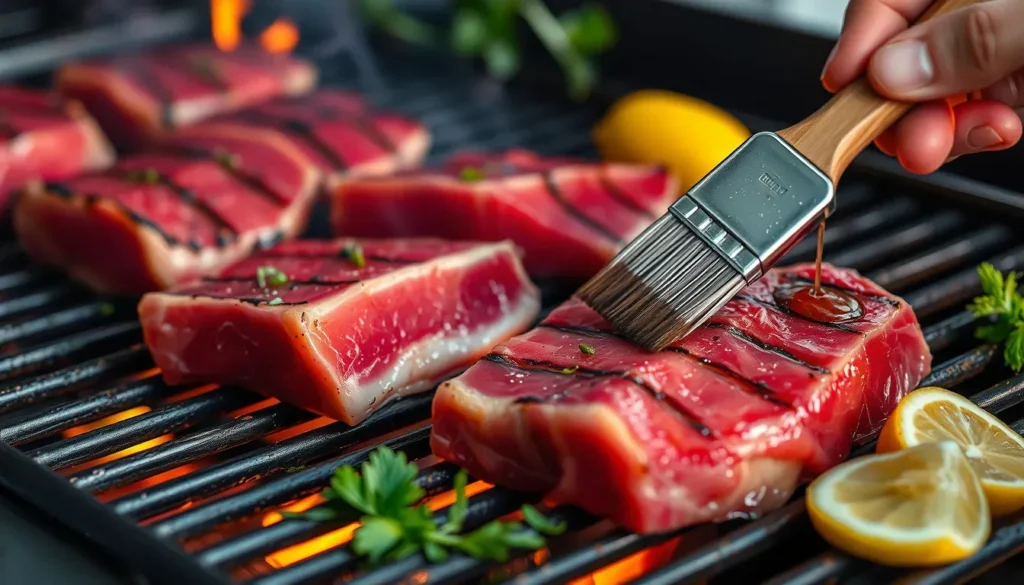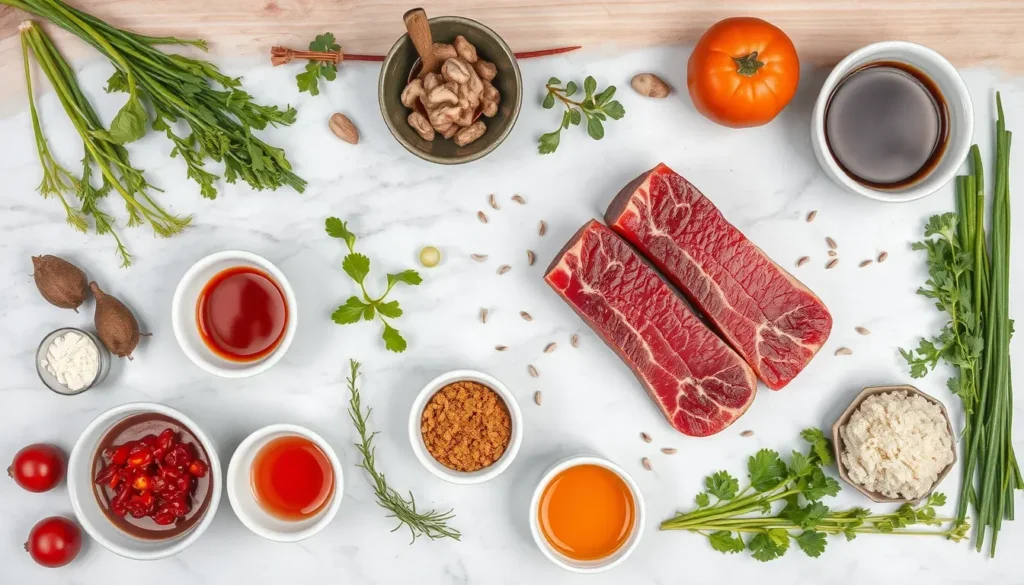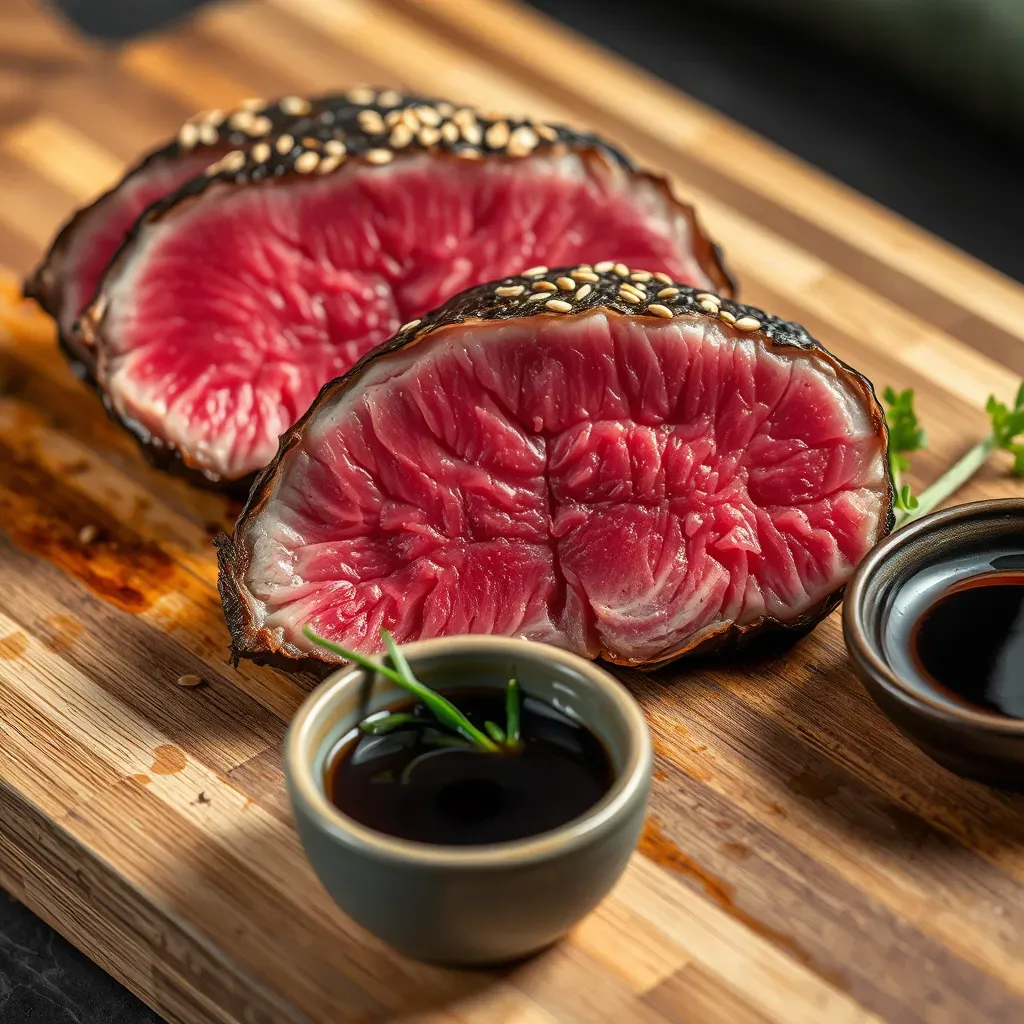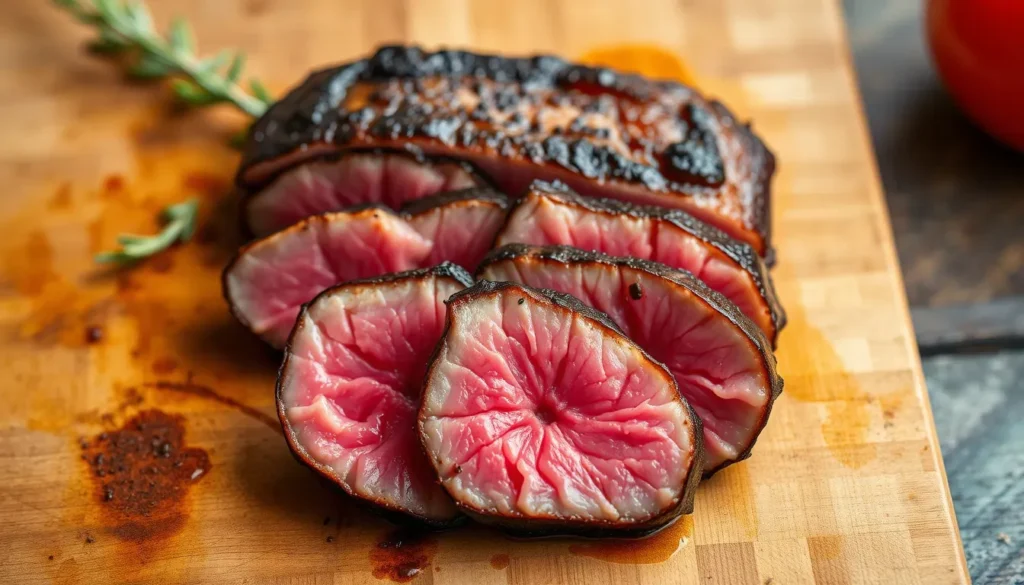Are you mesmerized by those gorgeous ruby-red ahi tuna steaks at the seafood counter but unsure what to do with them? You’re not alone. Ahi tuna is prized for its meaty texture, mild flavor, and stunning presentation potential—not to mention its impressive nutritional profile. But finding reliable, varied recipes that truly showcase this premium seafood can be challenging.
That’s why I’ve created this comprehensive guide to ahi tuna. After testing dozens of preparation methods in my kitchen, I can confidently say this is the only ahi tuna resource you’ll need. We’ll master the perfect sear, create vibrant poke bowls, fire up the grill, and explore elegant raw preparations—all with step-by-step instructions for foolproof results every time.
Choosing the Best Ahi Tuna
Before diving into recipes, let’s cover the fundamentals that will set you up for success.
Sushi-Grade vs. Steak-Grade
Sushi-grade tuna (sometimes labeled “sashimi-grade”) is the highest quality available. This fish has been quickly frozen at ultra-low temperatures to kill potential parasites, making it safe for raw consumption in preparations like poke and tartare. It’s typically deeper in color and more expensive.
Steak-grade tuna is still high-quality but may not meet the rigorous standards for raw consumption. This grade is perfect for searing and grilling where the fish will be partially or fully cooked.
What to Look For
When selecting ahi tuna (also known as yellowfin tuna), keep these quality indicators in mind:
- Color: Look for deep red or pink flesh with a translucent quality. Avoid tuna with brown spots or discoloration.
- Smell: Fresh tuna should smell clean and oceanic, never fishy or ammonia-like.
- Texture: The flesh should be firm and spring back when touched, not mushy or falling apart.
Where to Buy
For the highest quality:
- Specialty fish markets: Often your best bet for true sushi-grade options
- Higher-end grocery stores: Whole Foods, Fresh Market, and similar markets typically offer better quality seafood
- Online seafood suppliers: Services like Vital Choice or Fulton Fish Market deliver flash-frozen premium seafood directly to your door
Fresh vs. Frozen
Contrary to popular belief, frozen doesn’t mean inferior. Much “fresh” tuna was previously frozen for transport anyway. High-quality flash-frozen tuna preserves both safety and texture, often better than fish that’s been sitting “fresh” in transit or at the counter.

Handling & Preparation Basics
Safe Thawing
For frozen tuna:
- Refrigerator method (recommended): Place sealed frozen tuna in the refrigerator 24 hours before cooking
- Quick method: Submerge sealed tuna in cold water for 1-2 hours, changing water every 30 minutes
Never thaw at room temperature or in warm water, which promotes bacterial growth and degrades texture.
Cutting Techniques
Ahi tuna has a distinct grain (muscle fibers running in one direction). For the most tender results:
- For steaks: Cut perpendicular to the grain when portioning
- For poke/tartare: Cut against the grain into cubes
- For sashimi/crudo: Slice against the grain at a slight angle for maximum tenderness
Storage Safety
- Raw tuna: Use within 1-2 days of purchase, stored in the coldest part of your refrigerator
- Cooked tuna: Refrigerate within 2 hours of cooking; consume within 3-4 days
- Leftover poke: Because it’s essentially raw, consume within 24 hours for best quality and safety
Perfect Pan-Seared Ahi Tuna Steaks
There’s nothing quite like the contrast between a well-seasoned, caramelized crust and the buttery, rare center of a perfectly seared ahi tuna steak.
Ingredients:
- 2 ahi tuna steaks (6-8 oz each, about 1½-inches thick)
- 2 Tbsp high-heat oil (avocado, grapeseed, or peanut)
- 2 Tbsp sesame seeds (optional)
For the marinade:
- 3 Tbsp soy sauce or tamari
- 1 Tbsp toasted sesame oil
- 2 tsp fresh grated ginger
- 1 clove garlic, minced
- 1 Tbsp rice vinegar
- 1 tsp honey or maple syrup
- ½ tsp red pepper flakes (optional)

Instructions:
- Prepare the marinade: Whisk together all marinade ingredients in a shallow dish.
- Marinate the tuna: Add tuna steaks, turning to coat. Marinate for 15-30 minutes (not longer, as the acid can begin “cooking” the fish).
- Remove and pat dry: Take tuna from marinade and pat completely dry with paper towels. This is crucial for achieving a good sear.
- Season: If desired, press sesame seeds onto all sides of the tuna steaks.
- Heat the pan: Heat a heavy-bottomed skillet (cast iron works beautifully) over high heat until very hot, about 2 minutes.
- Add oil: Add oil to the pan and swirl to coat.
- Sear the tuna: Carefully place tuna in the pan and sear for exactly:
- 45 seconds per side for rare (cool red center)
- 1 minute per side for medium-rare (warm red center)
- 1½ minutes per side for medium (warm pink center)
- Rest: Transfer tuna to a cutting board and let rest for 1 minute.
- Slice and serve: Using a sharp knife, slice tuna against the grain into ½-inch pieces.
Pro Tips for Perfect Searing:
- Temperature matters: Bring tuna to room temperature for 15 minutes before cooking for more even cooking
- Control moisture: Thoroughly pat dry the tuna before searing—moisture is the enemy of a good crust
- Don’t move the fish: Once it hits the pan, let it cook undisturbed to develop a proper crust
- Watch the sides: You can see the cooking progress by looking at the side of the steak—the color change will rise from the bottom up
Vibrant & Authentic Ahi Poke Bowl
This Hawaiian classic showcases ahi tuna in its purest form—lightly marinated and served raw with complementary flavors and textures.
Ingredients:
- 1 lb sushi-grade ahi tuna, cut into ½-inch cubes
- ¼ cup soy sauce or tamari
- 2 Tbsp toasted sesame oil
- 1 Tbsp rice vinegar
- 1 tsp honey (optional)
- ¼ cup green onions, thinly sliced
- 2 Tbsp white or red onion, finely diced
- 1 tsp fresh ginger, grated
- 1-2 tsp sriracha or sambal oelek (optional, for heat)
- 1 Tbsp sesame seeds
For serving:
- 2 cups cooked sushi rice (or brown rice, quinoa, or greens)
- 1 avocado, sliced
- ½ cucumber, sliced or diced
- Edamame, seaweed salad, shredded carrots, sliced radish (optional toppings)
- Furikake seasoning (optional garnish)
Instructions:
- Prepare the base: Cook rice according to package directions, then cool slightly.
- Mix the marinade: In a medium bowl, combine soy sauce, sesame oil, rice vinegar, honey, green onions, white onion, ginger, and sriracha if using.
- Marinate the tuna: Gently fold in the diced tuna and let marinate for 15-30 minutes in the refrigerator (not longer for best texture).
- Assemble bowls: Divide rice between bowls. Top with marinated tuna mixture and arrange your chosen toppings around the bowl.
- Garnish and serve: Sprinkle with sesame seeds and furikake if using. Serve immediately.
Pro Tips for Perfect Poke:
- Temperature is key: Keep all ingredients well-chilled until just before serving
- Cut consistency: Try to maintain uniform cube sizes for the best texture experience
- Balance is everything: The perfect poke has a balance of savory, sweet, spicy, and umami flavors
- Make components ahead: Rice can be cooked and vegetables prepped hours ahead, but always marinate the tuna just before serving
Simple & Delicious Grilled Ahi Tuna
Grilling adds a delightful smokiness that complements ahi tuna’s rich flavor. This method is perfect for outdoor gatherings and summer meals.
Ingredients:
- 2 ahi tuna steaks (6-8 oz each, about 1½-inches thick)
- 1 Tbsp olive oil
For the grilling marinade:
- 3 Tbsp olive oil
- 2 Tbsp fresh lemon juice
- 2 cloves garlic, minced
- 1 Tbsp fresh herbs (thyme, rosemary, or oregano)
- 1 tsp honey
- ½ tsp salt
- ¼ tsp black pepper
Instructions:
- Preheat the grill: Set up for direct high heat cooking (450-500°F).
- Prepare the marinade: Whisk together all marinade ingredients in a shallow dish.
- Marinate the tuna: Add tuna steaks, turning to coat. Marinate for 15-20 minutes.
- Oil the grates: Just before grilling, clean and oil the grill grates well to prevent sticking.
- Grill the tuna: Remove tuna from marinade, lightly pat dry, and brush with the additional olive oil. Place on the hot grill and cook for:
- 1-2 minutes per side for rare to medium-rare
- 2-3 minutes per side for medium
- Rest and serve: Let the tuna rest for 2-3 minutes before slicing against the grain.

Pro Tips for Grilling:
- Watch for flare-ups: The oil in the marinade can cause flames—have a spray bottle of water ready
- Use tongs, not a fork: Piercing the fish will cause precious juices to escape
- Rotate for grill marks: For restaurant-quality presentation, rotate the tuna 45 degrees halfway through cooking on each side
- Don’t walk away: Tuna cooks extremely quickly on the grill—stay vigilant!
Elegant Ahi Tuna Tartare
This sophisticated appetizer showcases the premium quality and pure flavor of sushi-grade tuna.
Ingredients:
- ½ lb sushi-grade ahi tuna, finely diced
- 1 Tbsp shallot, minced
- 1 Tbsp capers, rinsed and chopped
- 1 Tbsp fresh chives, minced
- 1 tsp Dijon mustard
- 1 Tbsp olive oil
- 1 tsp fresh lemon juice
- Salt and freshly ground pepper, to taste
- Avocado slices and crackers or thinly sliced toasted baguette for serving
Instructions:
- Prepare the tuna: Using a very sharp knife, dice the tuna into ¼-inch cubes. Keep chilled until ready to mix.
- Combine ingredients: In a bowl, gently mix the tuna with shallot, capers, chives, mustard, olive oil, and lemon juice.
- Season: Add salt and pepper to taste, mixing gently to maintain the texture.
- Chill: Refrigerate for 15 minutes to allow flavors to meld.
- Serve: Use a ring mold or small bowl to shape the tartare into elegant portions. Serve with avocado slices and crackers or toasted baguette.
Pro Tips for Tartare:
- Quality is everything: Only use impeccably fresh, sushi-grade tuna for raw preparations
- Knife skills matter: A sharp knife prevents “mashing” the delicate fish
- Temperature control: Keep ingredients and plates chilled throughout preparation
- Presentation: Consider serving in individual portions for an elegant appetizer course
Marinades & Sauces Compendium
Enhance your ahi tuna dishes with these versatile marinades and sauces:
Citrus-Soy Marinade
Perfect for: Grilled or Seared Tuna
- ¼ cup orange juice
- 2 Tbsp soy sauce
- 1 Tbsp olive oil
- 1 tsp orange zest
- 1 clove garlic, minced
- 1 tsp fresh ginger, grated
Wasabi-Ginger Sauce
Perfect for: Seared Tuna or Tartare
- 3 Tbsp plain yogurt or mayonnaise
- 2 tsp wasabi paste (adjust to taste)
- 1 tsp fresh ginger, grated
- 1 tsp rice vinegar
- Pinch of salt
Citrus Ponzu
Perfect for: Poke Bowls or Tartare
- 3 Tbsp soy sauce
- 2 Tbsp fresh citrus juice (mix of lemon, lime, orange)
- 1 tsp mirin
- ½ tsp yuzu juice (if available)
- Pinch of bonito flakes (optional)
Perfect Pairings & Serving Suggestions
For Seared Tuna:
- Sides: Asian slaw, garlic green beans, wasabi mashed potatoes
- Wines: Pinot Noir, dry Riesling, or Sauvignon Blanc
- Beers: Japanese lager or wheat beer
For Poke Bowls:
- Sides: Miso soup, seaweed salad, edamame
- Wines: Dry Rosé or Grüner Veltliner
- Beers: Light lager or Hefeweizen
- Non-alcoholic: Iced green tea
For Grilled Tuna:
- Sides: Grilled vegetables, Mediterranean couscous, Greek salad
- Wines: Medium-bodied red like Syrah or crisp white like Albariño
- Beers: Amber ale or IPA
Frequently Asked Questions
Can I use frozen ahi tuna?
Yes! High-quality flash-frozen tuna works excellently for all these recipes. Just ensure it’s properly thawed following the guidelines above.
How do I know my ahi tuna is cooked?
Unlike other fish, ahi tuna is typically served rare or medium-rare in the center. The color changes from translucent deep red (raw) to opaque light pink (cooked). For most preparations, you’ll want to maintain that red center while searing the outside.
Is it safe to eat ahi tuna rare/raw?
When properly sourced and handled, sushi-grade ahi tuna is safe to eat raw. The fish must be labeled as sushi-grade or sashimi-grade, which means it has been frozen according to FDA guidelines to kill potential parasites.
What’s the difference between ahi tuna and yellowfin?
“Ahi” is actually the Hawaiian name for yellowfin tuna. Sometimes bigeye tuna is also marketed as ahi, but yellowfin is more common. Both are excellent choices for these recipes.
How long does ahi tuna last in the fridge?
Raw ahi tuna should be used within 1-2 days of purchase. Once cooked, tuna can be stored in the refrigerator for 3-4 days. Raw preparations like poke should be consumed within 24 hours.
Nutritional Information
Per 4 oz serving of ahi tuna (approximate values)
| Nutrient | Amount |
|---|---|
| Calories | 120 |
| Protein | 25g |
| Fat | 1g |
| Carbs | 0g |
| Omega-3s | 300mg |
Values will vary depending on preparation method and additional ingredients.
Ready to Elevate Your Seafood Game?
With these recipes in your culinary arsenal, you’re well-equipped to turn those gorgeous ruby-red ahi tuna steaks into restaurant-quality meals. Whether you prefer the elegant simplicity of a perfect sear, the fresh flavors of a poke bowl, or the smoky notes of grilled tuna, these techniques will ensure spectacular results every time.
Which ahi tuna preparation will you try first? Have a special tip for working with this premium seafood? I’d love to hear about your experiences in the comments below!
For more seafood inspiration, check out our [Comprehensive Guide to Cooking Fish at Home] or browse our [Healthy Seafood Recipes Collection].
Remember to tag us on social media when you create your stunning ahi tuna dishes!




